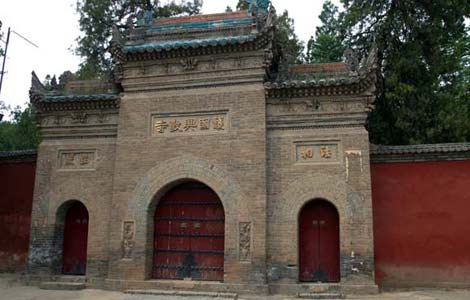
A gate of the Xingjiao Temple in Xi'an, Shaanxi province.Provided to China Daily
Experts called for more discussions and consultations on protecting a famous Buddhist temple, which was asked by the local government to remove most of its buildings.
Part of the Chinese section of the Silk Road, the Xingjiao Temple was told to remove the buildings as part of local government efforts related to the preparation for the Chinese Silk Road's UNESCO World Heritage Site application, authorities said on Wednesday.
Xingjiao Temple, in Duqu township in Chang'an district of Xi'an, Shaanxi province, is famous because the bone relics of a renowned Chinese Buddhist monk named Xuanzang were buried there.
The Tang Dynasty (AD 618-907) monk became famous for his 17-year overland journey to bring Buddhist scriptures from India to China, which provided the inspiration for the classical novel Journey to the West, written by Wu Cheng'en during the Ming Dynasty (1368-1644).
The temple, with a history of 1,300 years, will apply for the World Heritage List with the pagoda, where the remains of Xuanzang are buried.
The temple received a notice from the local government to remove almost two-thirds of its buildings before the end of May. Wang, the head of the publicity department of Chang'an district in Xi'an, confirmed the news to China Daily on Wednesday.
A team that includes experts from city planning, cultural relics preservation and architecture had conducted detailed field research for the preservation plan of the temple, he said.
The removal will focus mainly on those buildings constructed by the monks themselves, which have little value for cultural preservation, he told China Daily.
However, monks of the temple expressed their concerns about the plans.
The monks said they support the program, but they do not want to remove so many buildings, which will affect their daily religious life because different sections of the temple have their own functions, according to a report in Nanfang Metropolis Daily.
"Actually, the different suggestions from the two sides reflect two conceptions in terms of cultural relic protection," said Pang Shouyong, a professor of Minzu University of China in Beijing.

Copyright ©1999-2011 Chinanews.com. All rights reserved.
Reproduction in whole or in part without permission is prohibited.